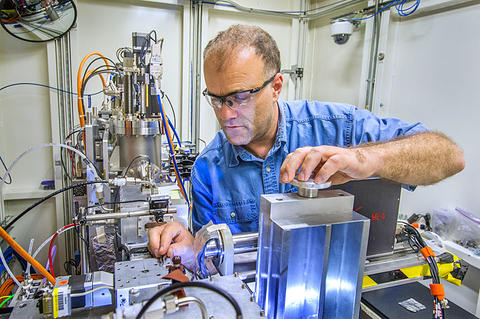X-ray Absorption Fine Structure (XAFS)

Bruce Ravel is the lead scientist at the Beamline for Materials Measurement (BMM), a new, state-of-the-art experimental station at NSLS-II.
The XAFS station uses a tunable, monochromatic, and moderately high energy X-ray beam (4.5 keV to 23.5 keV) for X-ray absorption spectroscopy measurements. The energy of the incident beam is tuned to the binding energy of an element of interest in the measurement sample. The absorption cross-section of that element is measured as a function of incident energy, yielding information about the valence state and atomic configuration about the target element. The X-ray Absorption Near Edge Structure (XANES) is a quick measurement which yields a direct measurement of valence state while the Extended X-ray Absorbtion Fine Structure (EXAFS) can be quantitatively analyzed for details of the atomic structure. By scanning multiple edges, the electronic and atomic structures of complex materials are revealed.
XAFS data often complements other measures of structure such as microscopy and diffraction. The focus on local structure rather than Bragg phenomena allows XAFS to be equally useful for all forms of condensed matter, including crystals, amorphous or glassy materials, macromolecules, surface sorbed species, and liquids. The ability to highlight the structure around the atom of interest facilitates measures of structure around low concentration dopants and impurities without concern for the majority matrix. The moderately high energy of the X-ray beam imparts a large mean free path of the emitted photoelectron, providing information at significant depth within a material. As a result, the technique is a powerful probe of multilayered materials common in microelectronic and nanofabrication products, of materials used for energy storage and conversion, and many other scientific areas.
Specifications/Capabilities
Information about the beamline, including training, control software, sample cameras, and upgrade activities can be found at the BMM Wiki.
Usage Information
Operating Schedule
Access Information
All users are encouraged to discuss potential experiments with the relevant instrument scientist (Bruce Ravel) prior to applying for access. Access to XAFS on BMM is granted through one of two mechanisms:
1) General users may apply for time through the general user program at NSLS-II. Qualifications, proposal templates, and guidelines are available at https://www.bnl.gov/ps/userguide/.
2) For NIST staff only: NIST projects may request access for experiments by contacting the instrument scientists listed here. Requests are collected and reviewed by the NIST BNL allocation committee and granted time based on merit and fit to the NIST mission. For more information, contact the instrument scientist listed here.

